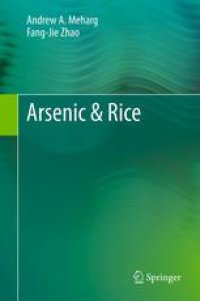
Ebook: Arsenic & Rice
- Tags: Agriculture, Plant Physiology, Biogeosciences, Environmental Management, Environmental Chemistry, Soil Science & Conservation
- Year: 2012
- Publisher: Springer Netherlands
- Edition: 1
- Language: English
- pdf
Rice is the staple food for half of the world’s population. Consumption of rice is the major exposure route globally to the class one, non-threshold carcinogen inorganic arsenic. This book explains the sources of arsenic to paddy soils and the biogeochemical processes and plant physiological attributes of paddy soil-rice ecosystems that lead to high concentrations of arsenic in rice grain. It presents the global pattern of arsenic concentration and speciation in rice, discusses human exposures to inorganic arsenic from rice and the resulting health risks. It also highlights particular populations that have the highest rice consumptions, which include Southern and South East Asians, weaning babies, gluten intolerance sufferers and those consuming rice milk. The book also presents the information of arsenic concentration and speciation in other major crops and outlines approaches for lowering arsenic in rice grain and in the human diet through agronomic management.
Rice is the staple food for half of the world’s population. Consumption of rice is the major exposure route globally to the class one, non-threshold carcinogen inorganic arsenic. This book explains the sources of arsenic to paddy soils and the biogeochemical processes and plant physiological attributes of paddy soil-rice ecosystems that lead to high concentrations of arsenic in rice grain. It presents the global pattern of arsenic concentration and speciation in rice, discusses human exposures to inorganic arsenic from rice and the resulting health risks. It also highlights particular populations that have the highest rice consumptions, which include Southern and South East Asians, weaning babies, gluten intolerance sufferers and those consuming rice milk. The book also presents the information of arsenic concentration and speciation in other major crops and outlines approaches for lowering arsenic in rice grain and in the human diet through agronomic management.
Content:
Front Matter....Pages i-xi
Introduction....Pages 1-9
Arsenic in Rice Grain....Pages 11-30
Risk from Arsenic in Rice Grain....Pages 31-50
Sources and Losses of Arsenic to Paddy Fields....Pages 51-69
Biogeochemistry of Arsenic in Paddy Environments....Pages 71-101
The Physiology of Arsenic in Rice....Pages 103-138
Strategies for Producing Low Arsenic Rice....Pages 139-151
Arsenic in Other Crops....Pages 153-166
Back Matter....Pages 167-171
Rice is the staple food for half of the world’s population. Consumption of rice is the major exposure route globally to the class one, non-threshold carcinogen inorganic arsenic. This book explains the sources of arsenic to paddy soils and the biogeochemical processes and plant physiological attributes of paddy soil-rice ecosystems that lead to high concentrations of arsenic in rice grain. It presents the global pattern of arsenic concentration and speciation in rice, discusses human exposures to inorganic arsenic from rice and the resulting health risks. It also highlights particular populations that have the highest rice consumptions, which include Southern and South East Asians, weaning babies, gluten intolerance sufferers and those consuming rice milk. The book also presents the information of arsenic concentration and speciation in other major crops and outlines approaches for lowering arsenic in rice grain and in the human diet through agronomic management.
Content:
Front Matter....Pages i-xi
Introduction....Pages 1-9
Arsenic in Rice Grain....Pages 11-30
Risk from Arsenic in Rice Grain....Pages 31-50
Sources and Losses of Arsenic to Paddy Fields....Pages 51-69
Biogeochemistry of Arsenic in Paddy Environments....Pages 71-101
The Physiology of Arsenic in Rice....Pages 103-138
Strategies for Producing Low Arsenic Rice....Pages 139-151
Arsenic in Other Crops....Pages 153-166
Back Matter....Pages 167-171
....